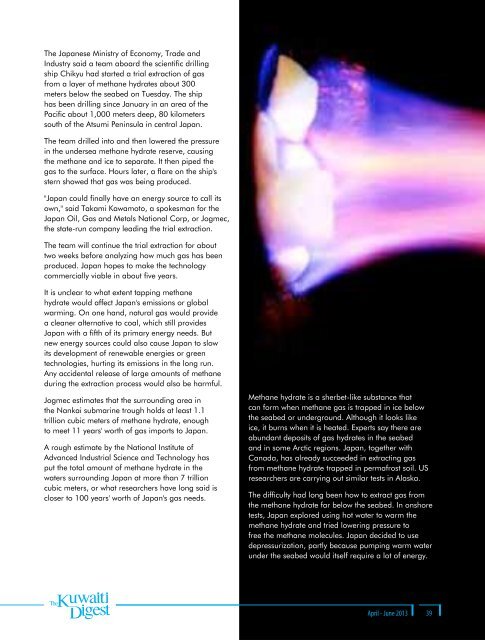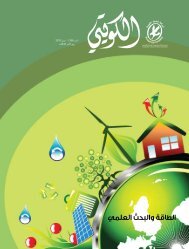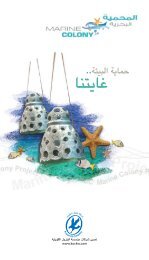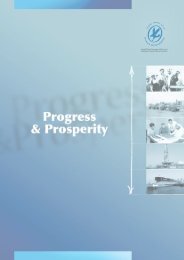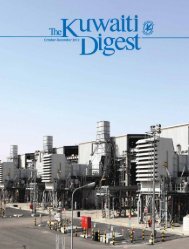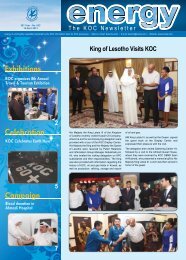6 - Kuwait Oil Company
6 - Kuwait Oil Company
6 - Kuwait Oil Company
You also want an ePaper? Increase the reach of your titles
YUMPU automatically turns print PDFs into web optimized ePapers that Google loves.
The Japanese Ministry of Economy, Trade and<br />
Industry said a team aboard the scientific drilling<br />
ship Chikyu had started a trial extraction of gas<br />
from a layer of methane hydrates about 300<br />
meters below the seabed on Tuesday. The ship<br />
has been drilling since January in an area of the<br />
Pacific about 1,000 meters deep, 80 kilometers<br />
south of the Atsumi Peninsula in central Japan.<br />
The team drilled into and then lowered the pressure<br />
in the undersea methane hydrate reserve, causing<br />
the methane and ice to separate. It then piped the<br />
gas to the surface. Hours later, a flare on the ship's<br />
stern showed that gas was being produced.<br />
''Japan could finally have an energy source to call its<br />
own,'' said Takami Kawamoto, a spokesman for the<br />
Japan <strong>Oil</strong>, Gas and Metals National Corp, or Jogmec,<br />
the state-run company leading the trial extraction.<br />
The team will continue the trial extraction for about<br />
two weeks before analyzing how much gas has been<br />
produced. Japan hopes to make the technology<br />
commercially viable in about five years.<br />
It is unclear to what extent tapping methane<br />
hydrate would affect Japan's emissions or global<br />
warming. On one hand, natural gas would provide<br />
a cleaner alternative to coal, which still provides<br />
Japan with a fifth of its primary energy needs. But<br />
new energy sources could also cause Japan to slow<br />
its development of renewable energies or green<br />
technologies, hurting its emissions in the long run.<br />
Any accidental release of large amounts of methane<br />
during the extraction process would also be harmful.<br />
Jogmec estimates that the surrounding area in<br />
the Nankai submarine trough holds at least 1.1<br />
trillion cubic meters of methane hydrate, enough<br />
to meet 11 years' worth of gas imports to Japan.<br />
A rough estimate by the National Institute of<br />
Advanced Industrial Science and Technology has<br />
put the total amount of methane hydrate in the<br />
waters surrounding Japan at more than 7 trillion<br />
cubic meters, or what researchers have long said is<br />
closer to 100 years' worth of Japan's gas needs.<br />
Methane hydrate is a sherbet-like substance that<br />
can form when methane gas is trapped in ice below<br />
the seabed or underground. Although it looks like<br />
ice, it burns when it is heated. Experts say there are<br />
abundant deposits of gas hydrates in the seabed<br />
and in some Arctic regions. Japan, together with<br />
Canada, has already succeeded in extracting gas<br />
from methane hydrate trapped in permafrost soil. US<br />
researchers are carrying out similar tests in Alaska.<br />
The difficulty had long been how to extract gas from<br />
the methane hydrate far below the seabed. In onshore<br />
tests, Japan explored using hot water to warm the<br />
methane hydrate and tried lowering pressure to<br />
free the methane molecules. Japan decided to use<br />
depressurization, partly because pumping warm water<br />
under the seabed would itself require a lot of energy.<br />
April - June 2013 39


